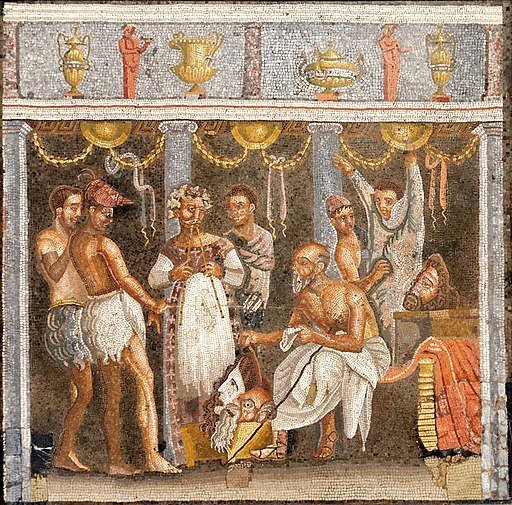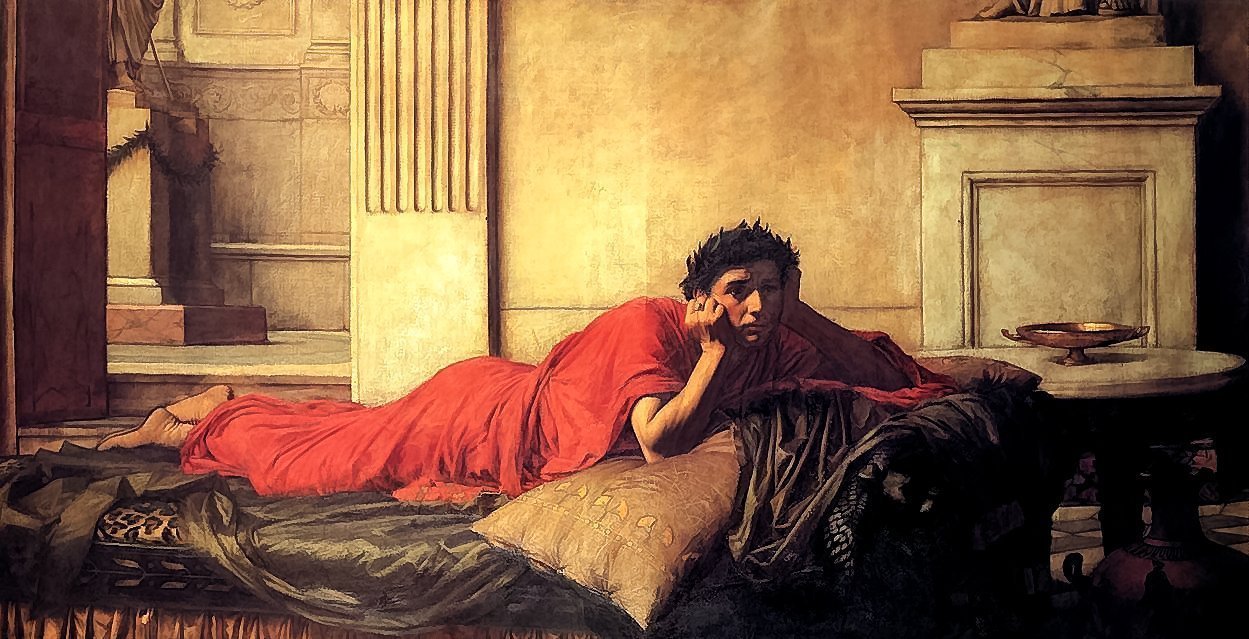You have probably heard someone call Latin a “dead language.” There was a time, however, when Latin was very much alive and young. While students who learn Latin today appreciate its eloquence and beauty, Latin’s early form was rough and immature.
This is the story of the first 500 years of Latin’s life.
Latium and the Founding of Rome
So, how old is Latin? To put it briefly — about 2,700 years old.
The birth of Latin took place around 700 BC in a small settlement sloping up towards Palatine Hill. The speakers of this language were called Romans, after their legendary founder, Romulus.
At the time, Rome was not a powerful empire. Far from it, the Romans were an insignificant people group with a population of a few thousand. They slept in windowless huts, spoke their own language, worshipped their own gods, and enjoyed their own way of doing things — just like so many other groups to be found in Italy at the time.

They did not call it Italy back then. The Romans lived in Latium. Latium was not a country, but a region. At the time, it was a diverse place. Latium was home for many groups. While they were related, each had its own ethnicity, religion, social organization, and — importantly — language. While millions today speak German or English, it was not uncommon back then for a language to be spoken by just a few thousand people. In fact, fewer languages are spoken today than in the ancient world. Further, more languages have died and disappeared than exist today.
READ MORE: When Did Latin Die?
The Romans were just one group out of many in the Latium region. Not only that, but they weren’t especially impressive. The Etruscans to the north, in modern-day Tuscany, were much more numerous and powerful. (Unlike the Romans, who lived on just one settlement, the Etruscans boasted many city-states.)
No one at the time would have guessed that, within a few centuries, everyone in the region would be speaking the tongue of the Romans.
Old Latin/Archaic Latin
To create a distinct language, all you have to do is form a small tribe and live without contact with other groups for a time. This is what happened over two millennia ago. According to legend, Rome was founded in 753 BC by twin brothers, Romulus and Remus. Some accounts claim these siblings were the children of Mars, the god of war.
In any event, their relationship was certainly war-like. Shortly after the two set out to found a city together, Remus mocked the walls his brother had built on Palatine Hill. Romulus lost his temper and murdered his sibling.
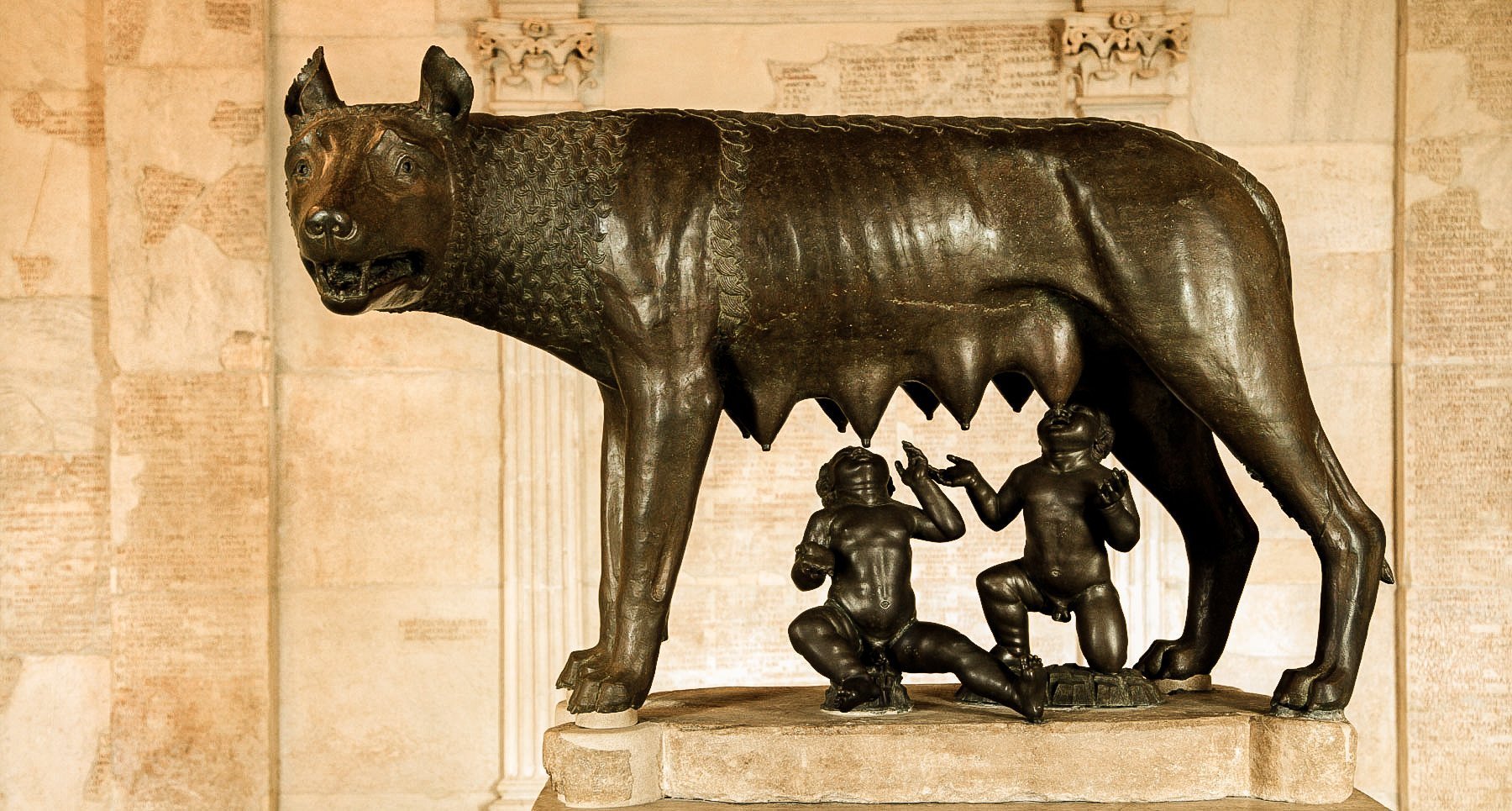
While much of this story is likely fiction, most scholars agree with the date of Rome’s founding in the mid-8th century BC. Latin first appeared on Palatine Hill, as the distinct tongue of a small people group. In fact, the site where this settlement was founded is believed to be the exact spot as the Forum Romanum (i.e., “the Roman Square”). The Forum Romanum was to be recognized as the heart of the city of Rome — and therefore of the Roman Empire — throughout antiquity. You can still visit it today.
The language spoken by Rome’s founders would have resembled languages spoken by neighboring peoples, from which it had been derived. We do not know what language the founders of Rome spoke before Latin developed, but it bore a close resemblance to Oscan and Umbrian dialects.
By comparing ancient manuscripts of all three languages, it is evident that they share very similar vocabulary and grammar. But they are not so similar that knowing how to interpret one means you can interpret the others. The comparison is similar between Italian and Spanish. However, because they are in the same language family, linguists refer to these three languages — Latin, Oscan, and Umbrian — as the Italic languages.
How these languages are related is unclear. They might be siblings, sharing a common (and long-extinct) mother tongue. Or maybe one of them is the mother tongue of the others? It is not yet possible to say with certainty.
Written Latin
What is true of babies tends to be true of societies. They begin by speaking and only later pick up writing. Languages, as a rule, begin their lives orally. Materials like alphabets can take centuries to appear. The invention of writing is a watershed moment in the history of any language.
The question is: How long did ancient Romans speak Latin before they put it into writing? According to archeological evidence, it wasn’t long.
Archeologists have found an inscription on a stone in the Forum Romanum which has been dated to the 6th century BC. While it is mostly illegible, it is clear that Latin letters were being used. This is the earliest known example of Latin writing. There is also a golden cloak pin, called the “Praeneste Fibula,” that dates to the same period with the inscription, “Manios me fhefhaked Numasioi.”
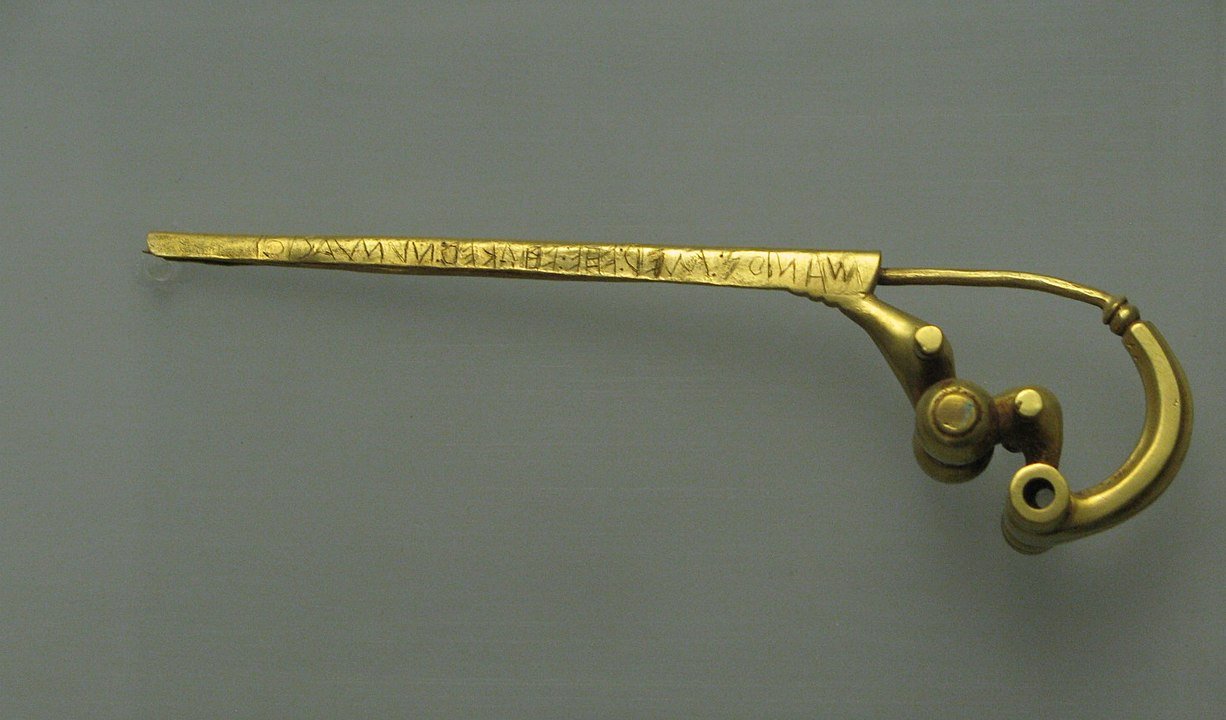
At the time, Latin did not have standard spelling or grammar. Whoever etched this sentence was just spelling it the way it sounded. There did not exist a single correct (or incorrect) way to spell anything. This would eventually change.
In Classical Latin, which is what most students study today, it would say, “Manius me fecit Numerio,” which means in English: “Manius made me for Numerius.” It seems Manius was a goldsmith who liked to leave his mark on his work. All this evidence means Latin appeared in writing shortly after Rome was founded. Written Latin is at least two and a half thousand years old, and possibly even older.
How did the Romans develop writing so quickly? Well, they had a little help. They did not develop their own original alphabet. Instead, they borrowed the Etruscan alphabet and tweaked it slightly.
Etruscan Influence and the Latin Alphabet
The Etruscans, if you remember, were the Roman’s larger and more powerful northern neighbors. They spoke their own language. It did not belong to the Indo-European language family like the Italic languages. In fact, Etruscan is not related to any other known language, dead or alive!
The Romans were mostly farmers, so they had much to gain from the more advanced Etruscans. From an early point, the two peoples developed a close relationship and traded a great deal. Not only did the Romans borrow the alphabet from the Etruscans, but they also acquired a few new vocabulary words, like persona (person) and fenestra (window).
These vocabulary words indicate other things the Romans gained from their relationship with the Etruscans — like new technology! As we’ve mentioned, the Romans originally slept in huts without windows. From the Etruscans, the Romans learned how to build houses with fenestrae — windows.
The Etruscan word persona originally meant a theatrical mask. The mask depicted the role, or “person,” the actor was playing. This suggests that the Etruscans also introduced the Romans to theater, which would become a major part of Roman culture.
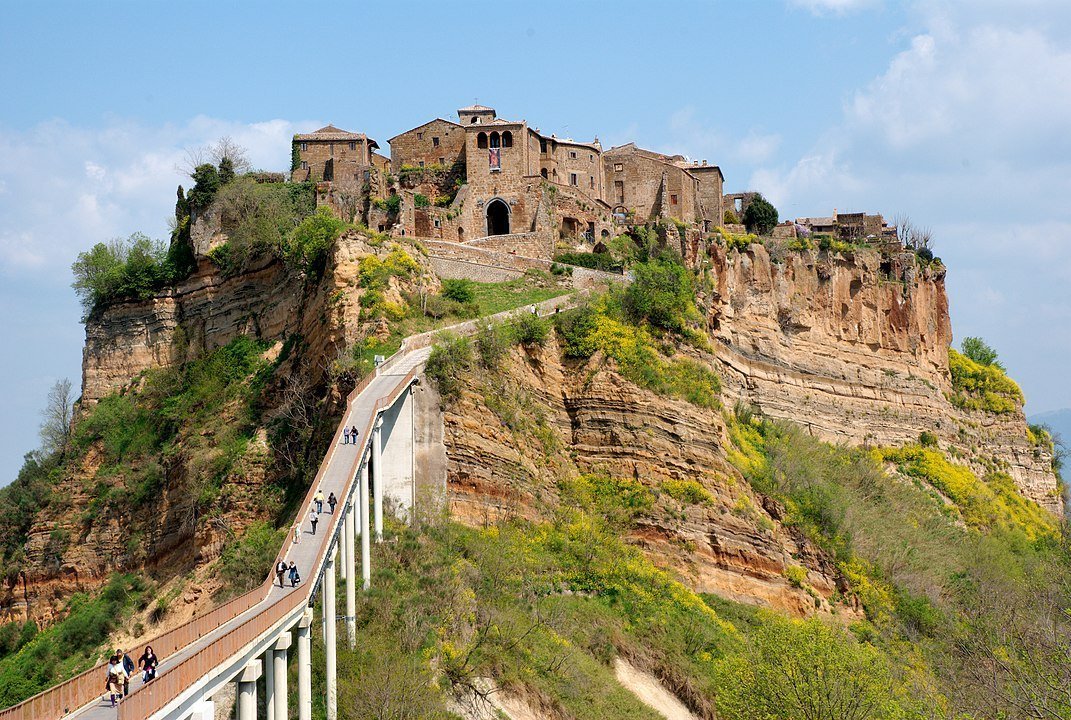
Today, this alphabet is known as the Roman alphabet, even though the Romans did not invent it. However, because of the influence of Latin, this alphabet has been inherited by all western European languages — including English.
The Romans of Latium adopted the Etruscan alphabet as well as their technology and culture. But you won’t meet any Etruscans nowadays, no matter how hard you search through Italy. What happened?
Imperial Expansion and Standardization
After murdering his brother, Romulus became the first Rex, or King, of Rome. He would be succeeded by six kings before a revolution ended the monarchy.
While still a monarchy, Rome depended a great deal on its powerful neighbors to the north, the Etruscans. Not only did they trade with each other, but even a few of Rome’s original kings were Etruscan! This would contribute to the monarchy’s downfall since the native Romans did not like being ruled by a foreign king.
While Rome was a monarchy, it had been conquering its neighbors and slowly expanding until its walls were rebuilt to enclose the Seven Hills of Rome. (The Roman Empire would not encircle the entire Mediterranean until about 70 AD.) Rome was becoming more powerful.
The last Roman Rex was an Etruscan called Tarquin the Proud. He was overthrown and with him, the monarchy fell. Rome transitioned from a Kingdom, under a Rex, to a Republic.

The word Republic comes from two Latin words: Res (thing, affair) and Publica (the people). So a Republic literally means “the People’s Affair.” It was a representative form of government ruled by two men called Consuls, who were elected into office by Roman citizens. Beneath the Consuls, a few hundred other men formed a Senate. According to legend, the Republic was founded in 509 BC. Most scholars agree there’s little reason to question this date.
When Rome became a Republic, her expansion into an empire really took off. Since the 5th century, Rome fought war after war with her neighbors. As her borders absorbed the neighboring states, the Roman tongue gradually became the standard language across the region. By 270 BC, the Romans were the undisputed masters of the entire Italian peninsula.
This meant that the Roman language was now coming into its own as a real, respectable language. It was now the language of the entire region of Latium. In fact, nobody called it the Roman language anymore. Now it was the Latium language — that is, Latin.
The Latium Language
As we’ve said, millennia ago, modern-day Italy was peopled by speakers of many different languages. Most of these languages no longer exist. How did they disappear, and how did their speakers learn Latin?
Let’s start by answering how they did not learn Latin: By going to Latin school. There were no Latin grammar books or dictionaries at this time. Not even Romans taught Latin in their schools. In fact, the Romans did not seem to be much interested in writing at all in these early centuries. The first individuals who could be called writers do not appear until the 3rd century BC, and what we have of these are mostly fragments.
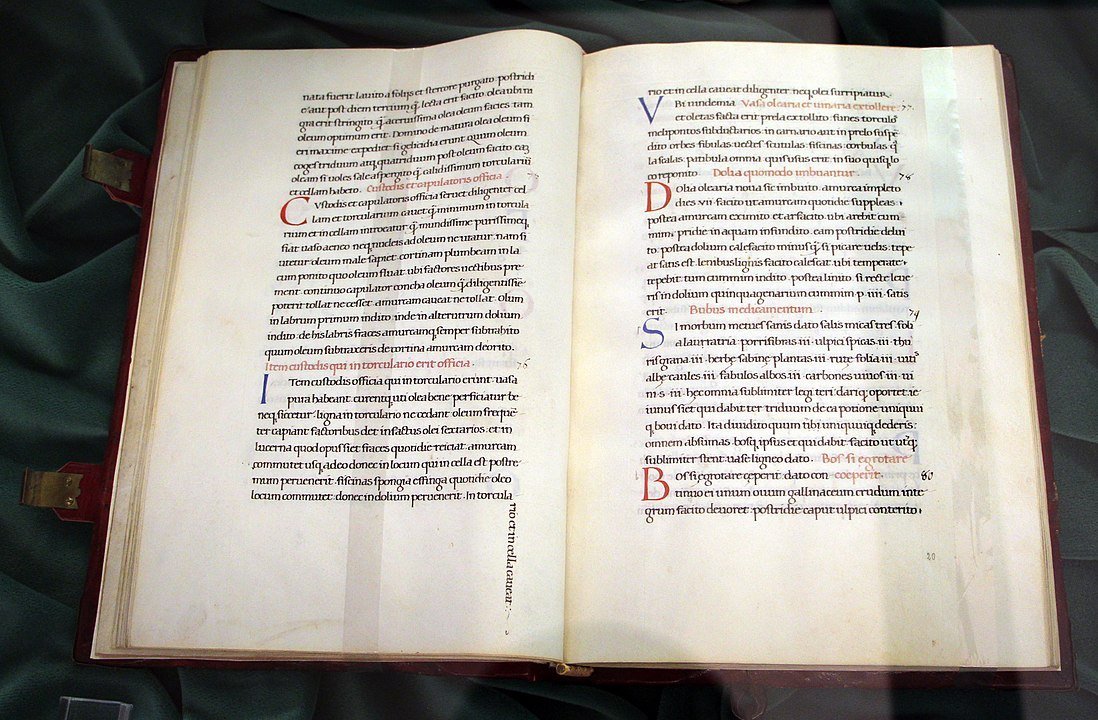
One of the very oldest voices from Rome’s ancient past is a Senator named Marcus Porcius Cato, or Cato the Elder. He died in 149 BC. His book De Agri Cultura (On Agriculture) is one of the very oldest books which exists in Latin. It’s a fascinating little book.
Basically, it’s a Roman homesteader’s handbook. From it, you can learn how to build an olive press or how to bake a honey cake. Cato gives us a small glimpse into what ancient Romans valued. According to Cato, the highest praise you can give a Roman is to call him, “Bonum agricolam bonumque colonum!”
In English, this means, “A good farmer and a good husbandman!” For ancient Romans like Cato, this was the highest compliment imaginable.
How Latin Spread
In addition to farming, the other most important job in ancient Rome was soldiering. In fact, the biggest reason the Roman language spread throughout Latium was Romans were very good at both of these.
After Rome conquered a new territory, parcels of land would be awarded to Latin-speaking soldiers who had completed their military service. The soldiers would trade in their weapons for farm tools and move in with their entire families to cultivate the land and build homes. This practice created “islands” of Latin in other language areas.
These islands maintained contact with the Roman capital while trading and socializing with their non-Roman neighbors. Because Latin was the language of power and trade, conquered peoples learned to pick it up quickly. After a few generations, Latin gradually became the vernacular language of the peoples the Romans had subjugated.
READ MORE: Is Latin a Dead Language?
If this sounds like colonization, you’d be right. A soldier, miles in Latin, could become a colonus, or grower. A group of such coloni formed a colonia, which is a number of Romans living together in a conquered country. This is where English gets the word “colony.”
Roman expansion spelled the death of many languages. We occasionally find traces of these in ancient Roman literature, as bits of vocabulary. Scholars have labored to reconstruct a few of these languages, but many are unsalvageable. It is not even known exactly how many languages were erased by Rome’s imperial march.
On the other hand, we should remember that Italy was still extraordinarily diverse in terms of ethnicity, social and political organization, religion, and material culture in those early days. The gradual standardization of Latin, however, ended up creating a common identity throughout Italy. One could say the standardization of Latin was itself the creation of Italy.
The Greek Encounter
Today, Latin is known for its literary elegance, but in its early centuries, Rome had produced no great poets, philosophers, or playwrights. Very little written work in Latin exists from before 200 BC, and these are mostly inscriptions on gravestones and such. Clearly, ancient Romans did not bother much with writing. They were good at two things: farming and war.
And these complimented each other terrifyingly well, as we’ve seen. But when it came to literature, education, philosophy, science, art, and music, the Romans did not produce much. But this would soon change.
As Rome continued to expand, it came into contact with the Greeks and eventually conquered them by 133 BC. Walking into a Greek city, the Romans were awed by what they found. Greece was an advanced culture. The architecture, the statues, the plays, the politics — Greece was everything Rome wasn’t! This contact would lead to a great flowering for the Latin language.
At first, the Romans were just copy-cats. They took Greek culture and adapted it for a Roman audience. It seems the first type of literature the Romans plagiarized from the Greeks would be the one they already knew a little something about: theatrical plays! (They had learned theater from the Etruscans, if you recall.) Some of the oldest Latin literature we have are the plays written by Plautus around 200 BC.
Surprisingly enough, the encounter between Greek and Latin was actually a family reunion. Linguists describe the relationship between Latin and Greek as cognate: This means they are actually siblings. Though the two would have a long history together, neither pre-dates the other. Rather, both descend from a common mother language. This mother language remains unknown — perhaps she was numbered among the casualties of imperial expansion?
Classical Latin
We often contrast Latin with “barbarian” languages, but for a long time, Latin looked rather barbarous herself. Before encountering the Greeks, early Latin was a language for warfare, trade, and law. It was muscular, practical, and unrefined.
But by imitating Greek culture, Latin writers cut their teeth on literature, poetry, and music. They would eventually tap into their artful side, find their own voice, and become a Classical Language like Greek.
In the late Roman Republic, the Latin language made huge advances. Works were produced which showed this Italic language was capable of great eloquence, subtlety, precision, and lyricism.
The Romans would invent a term for the literature which appeared during this period. Nodding to the Greeks to whom they owed so much, they took the Greek word ἐγκριθέντες (encrithentes), which means “select” or “approved,” and coined the term classicus. Thus Classical Latin was born.
For centuries, the works from the Classical period would be the model for proper Latin as opposed to vulgar Latin. The first books on Latin grammar and spelling were soon to follow. The earliest seems to have been De Lingua Latina Libri XXV, a series of 25 books written by the Roman scholar Marcus Terentius Varro in the 1st century BC. This helped create a standard form of Latin which slowed the rate of change.
Latin the Living Dead Language
A few centuries after Christ, late Latin became the equal of Greek as a language of literature, philosophy, science, and theology. When the Roman Empire collapsed, Latin carried on. Even after no one spoke it as a first language, it continued to be spoken as the official language of educated discourse. It seemed a shame to let it go to waste.
And to this day, despite being declared “dead,” meaning there are no native speakers, Latin carries on remarkably well.
For modern people, learning Latin creates the opportunity to converse with the past. There are thousands of books in Latin since it was spoken for centuries even after it died, and only a fraction of these have been translated into English!
Latin also helps us converse with the Romance languages of the present! (Get it? Roman-ce languages!) French, Spanish, Portuguese, Romanian, Italian — all of these and more are direct descendants from Latin. The resemblance is so striking that by learning Latin, you could learn to pick up any Romance language in record time.
Just because Latin is no longer a native language does not mean it isn’t still an official language in some parts of the world. If you visit Vatican City today, you will find the Roman Catholic Church still publishes all major documents and decisions in Latin. Since the Roman Catholic Church has been an international institution since the early middle ages, this actually helps them overcome modern language barriers.
Finally, English has much to gain from making contact with Latin, just like Latin had much to gain from contacting Greek. Even though English is not a Romance language, she has been deeply formed by Mother Latin over the centuries. So much so, we could say English is one of her adopted children! Maintaining this relationship could help to enrich and beautify English as it continues to develop.

Blake Adams is Latin Fellow at The Ancient Language Institute. He is a historian and Patristics scholar, and a graduate student at Wheaton College.
The Ancient Language Institute exists to aid students in the language learning journey through online instruction, innovative curriculum, and accessible scholarship about the ancient world and its languages. Are you interested in learning Latin?

